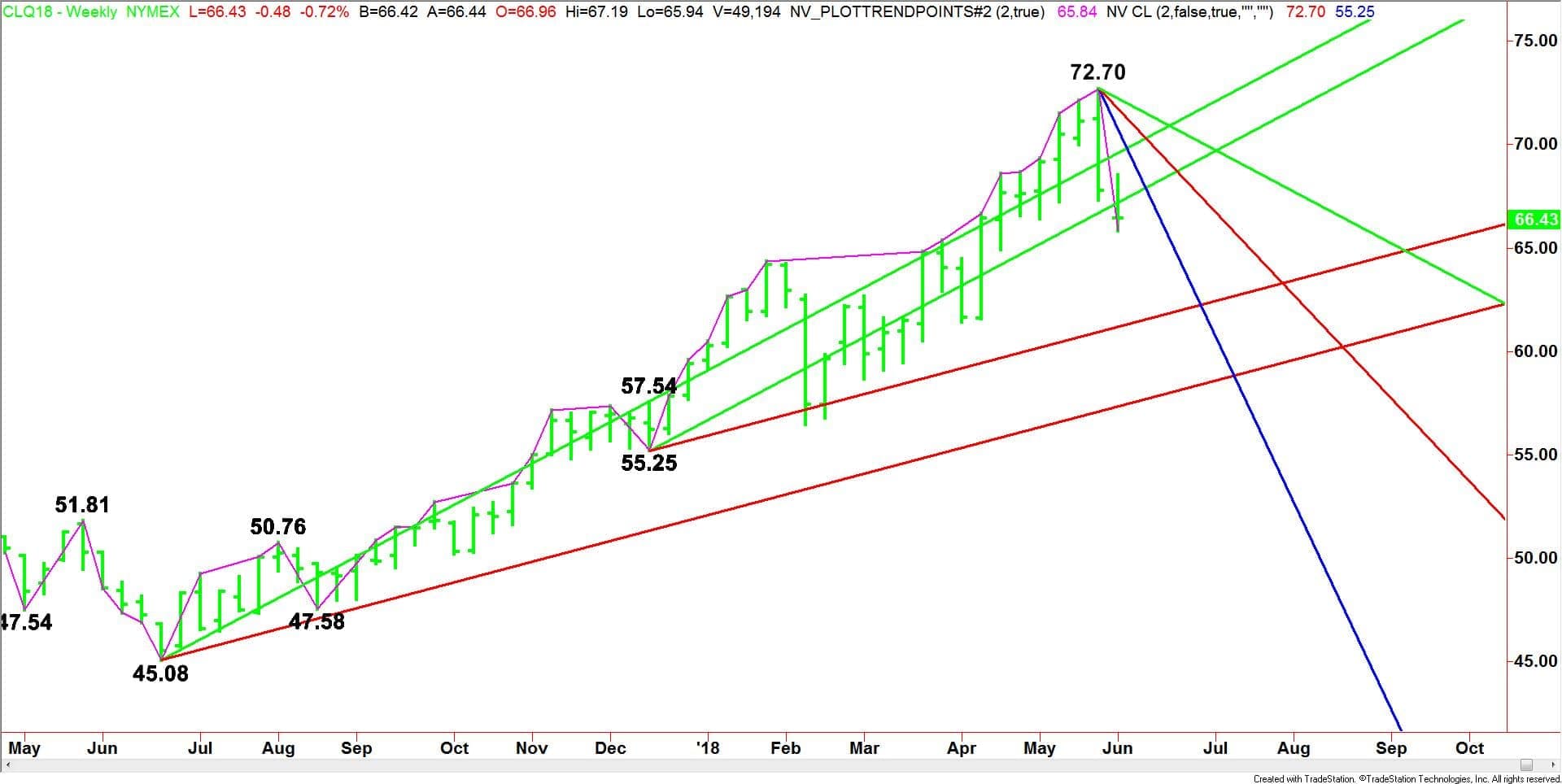U.S. West Texas Intermediate crude oil is in a position to close lower for a second consecutive week. The catalysts behind this week’s selling pressure are trader reaction to a new all-time high in U.S. production and continued worries over expectations of higher OPEC output.
According to the U.S. Energy information Administration in its monthly report, U.S. crude oil production jumped 215,000 barrels per day (bpd) to 10.47 million bpd in March, the highest on record.
In other crude oil news, oil imports from Venezuela dropped more than 3 million bpd to 13.21 million bpd in the month, approaching the all-time low 13.20 million bpd, reported in January of 2003.
Gasoline demand in March was 9.4 million bpd, up 1 percent, or 94,000 bpd from a year earlier, according to the report. At the same time, gasoline exports rose to 951,000 bpd, up 361,000 bpd from a year earlier.
Distillate fuel exports were 1.15 million bpd in the month, down about 12,000 bpd from a year earlier. Demand for distillate fuels, including diesel and heating oil was 4.2 million bpd, up 0.4 percent, or 15,000 bpd, from a year earlier.
In other news, U.S. crude stockpiles fell 3.6 million barrels in the week-ending May 25, the EIA said, exceeding expectations for a decline of 525,000 barrels.
Prices were holding steady at the end of the week because the drop in inventories in the U.S. was overshadowed by the jump in production to a record high level. Besides, at this time,…
U.S. West Texas Intermediate crude oil is in a position to close lower for a second consecutive week. The catalysts behind this week’s selling pressure are trader reaction to a new all-time high in U.S. production and continued worries over expectations of higher OPEC output.
According to the U.S. Energy information Administration in its monthly report, U.S. crude oil production jumped 215,000 barrels per day (bpd) to 10.47 million bpd in March, the highest on record.
In other crude oil news, oil imports from Venezuela dropped more than 3 million bpd to 13.21 million bpd in the month, approaching the all-time low 13.20 million bpd, reported in January of 2003.
Gasoline demand in March was 9.4 million bpd, up 1 percent, or 94,000 bpd from a year earlier, according to the report. At the same time, gasoline exports rose to 951,000 bpd, up 361,000 bpd from a year earlier.
Distillate fuel exports were 1.15 million bpd in the month, down about 12,000 bpd from a year earlier. Demand for distillate fuels, including diesel and heating oil was 4.2 million bpd, up 0.4 percent, or 15,000 bpd, from a year earlier.
In other news, U.S. crude stockpiles fell 3.6 million barrels in the week-ending May 25, the EIA said, exceeding expectations for a decline of 525,000 barrels.
Prices were holding steady at the end of the week because the drop in inventories in the U.S. was overshadowed by the jump in production to a record high level. Besides, at this time, traders are more concerned about supply-side issues in OPEC. These worries have driven the Brent-WTI spread out to nearly $11 barrels, the highest level in three years.
Helping to limit gains is the news that OPEC and other major non-OPEC producers, including Russia, may be planning to increase production by as much as 1 million barrels per day. Currently, OPEC and its allies are committed to slashing production by 1.8 million bpd until the end of 2018.
Providing some light support was a report that Russia’s central bank expressed concerns about raising output.
Finally, there’s a bottleneck in the U.S. supply chain that is contributing to the decline in U.S. futures as well. According to reports, prices for physical barrels of U.S. light sweet crude delivered at Midland are at their largest discount to the benchmark U.S. futures price in almost four years.
Weekly August West Texas Intermediate Crude Oil Technical Analysis

(Click to enlarge)
The main trend is up on the weekly chart, but the closing price reversal top formed the week-ending May 25 signals a shift in momentum to the downside.
A trade through $72.70 will negate the chart pattern and signal a resumption of the uptrend.
The market is currently trading inside the futures contract 50% to 61.8% retracement zone at $64.67 to $70.51. This zone is controlling the longer-term direction of the market.
The short-term range is $55.25 to $72.70. Its retracement zone is $63.98 to $61.92.
The main range is $45.08 to $72.70. Its retracement zone is $58.89 to $55.63.
The combination of the 50% level of the contract retracement zone and the short-term retracement zone creates a support cluster at $64.67 to $63.98. This zone is the primary downside target. Since the main trend is up, buyers are likely to come in on a test of this area.
If $63.98 fails as support then look for the selling to extend into $61.92.

(Click to enlarge)
The weekly Gann angle chart indicates developing weakness. Last week, the crude oil market crossed to the weak side of a pair of uptrending Gann angles that had provided support and guidance for a number of weeks. This indicates the selling is greater than the buying at current price levels.
Based on the current price at $66.48, the nearest Gann angle resistance next week is a steep downtrending Gann angle at $66.70. This angle is dropping $1.00 per week. Look for the selling pressure to continue as long as the market remains under this angle.
Overtaking the angle at $66.70 will signal the return of buyers. This could lead to a test of a pair of downtrending Gann angles at $69.70 and $71.20. The latter is the last potential resistance angle before the $72.70 main top.
The daily chart indicates there is plenty of room to the downside. The next potential support angle comes in at $61.50.
Technical Analysis Forecast
Although the main trend is up, traders should look for the downside momentum to continue as long as the market stays below the downtrending Gann angle at $66.70.
If the downside momentum continues then look for the selling to extend into $64.67 to $63.98. We could see a technical bounce on the first test of this area.
If $63.98 fails as support then look for the selling to continue with targets coming in at $61.92 to $61.50.
All bets are off on the selling pressure continuing next week if buyers can overtake $66.70. In this case, look for a sideways-to-higher trade.
Prices could remain rangebound today as investors continue to adjust to the new price levels and as they continue to assess the current supply/demand situation. Barring any major announcements over the near-term, crude is likely to drift sideways-to-lower until the OPEC meeting on June 22.
















